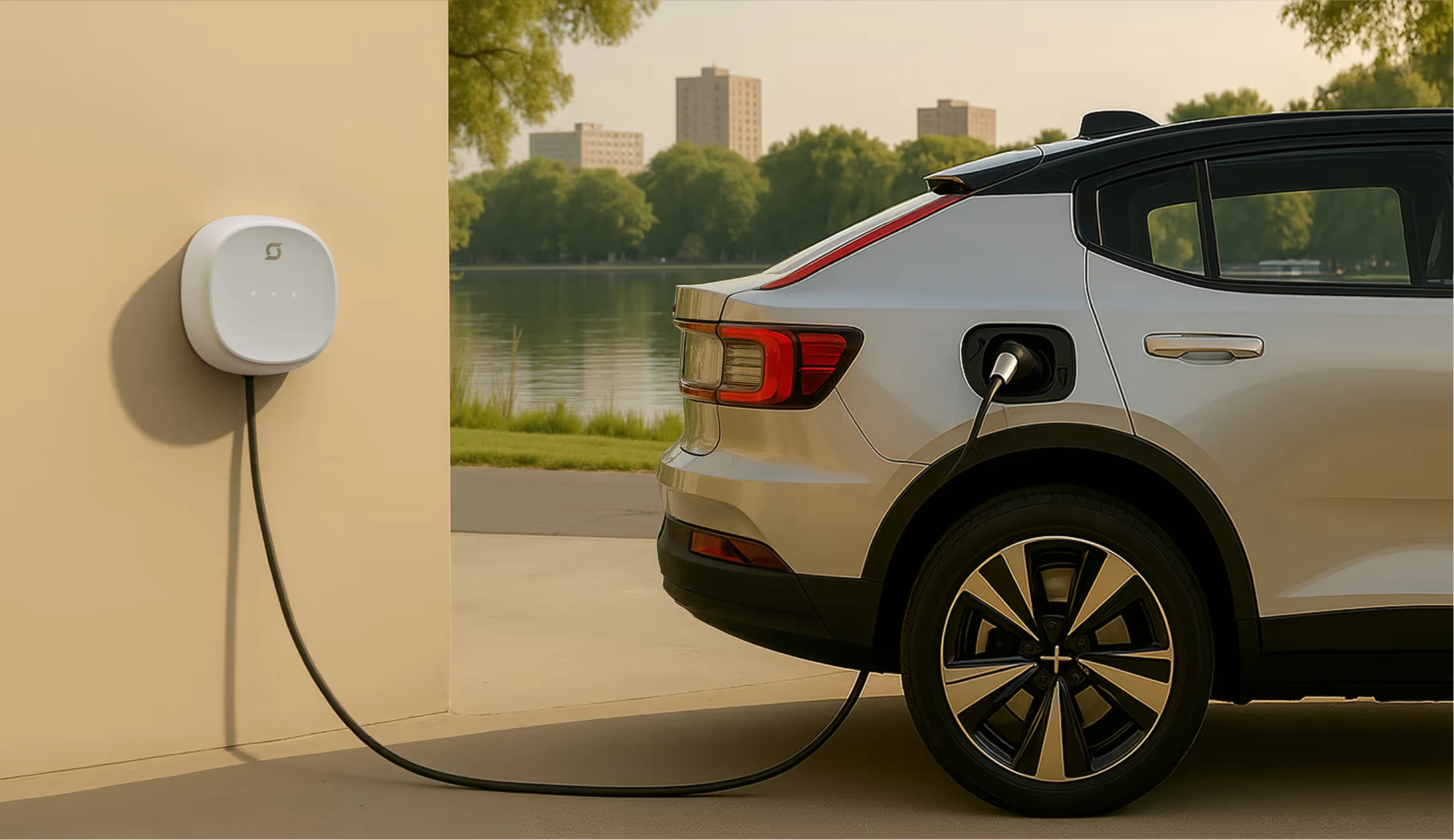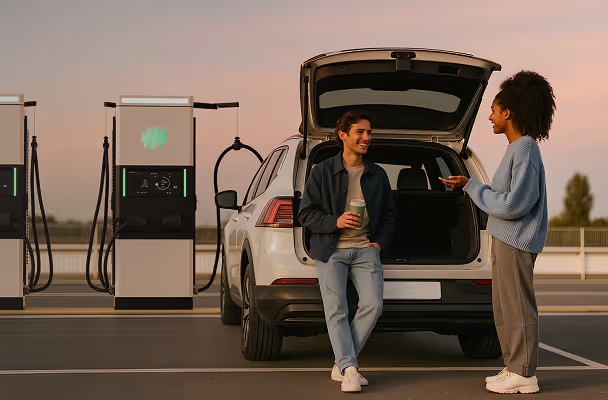How to Set Up EV Charging Infrastructure for Residential Projects

Electric vehicles are rapidly becoming mainstream in India, with city dwellers leading the way. A twofold increase was noted just this September (2025). For property developers, especially in urban spaces, integrating EV-ready infrastructure offers a market advantage and future cost savings by avoiding retrofits.
But what exactly is to be done, why is it to be done, and how? This is what this blog is about.
EV charging is a new residential expectation
Electric mobility in India is expanding rapidly, and EV-ready homes are becoming a key expectation among buyers. With 80% of users now charging at home, residential EV charging has shifted from being a luxury to a standard feature. Many purchasers are increasingly prioritising real estate with EV-ready parking spaces.
Real Estate developers must build EV charging in new projects
Incorporating EV charging infrastructure during the construction phase saves significant time, money, and effort. By planning for EV readiness early, through measures like laying conduits, reserving space in distribution boards, and managing load capacity, developers can avoid costly retrofits and delays later. This approach not only meets compliance needs but also acts as a strong market differentiator, appealing to modern homebuyers who increasingly prefer properties with built-in EV provisions.
Market trends reinforce this advantage, with surveys showing up to a 10–12% higher buyer preference for EV-ready homes. Projects planned with EV infrastructure also experience smoother coordination with utilities and faster installation timelines. Ultimately, early planning future-proofs developments, strengthens brand reputation, and ensures seamless operations in the long run. Since most vehicles remain parked in residences overnight, home EV charging fits naturally into daily life. Moreover, integrating cables, meters, and conduits during construction is far more cost-effective than retrofitting later. For developers, this forward-thinking approach enhances property value, boosts sales appeal, and strengthens market competitiveness.
Different projects have different requirements
Not every residential project has the same charging needs. A high-rise apartment block will require a different setup than a gated villa community. Understanding the building’s typology, parking layout, and usage patterns helps in designing the right combination of chargers, meters, and smart systems.
High-rises and gated communities
In large residential towers and gated communities, developers must carefully balance transformer capacity with the charging needs of multiple residents. Undersized systems can cause grid strain and costly retrofits later.
The best solution is to pre-wire a portion of parking bays with EV-ready conduits and reserve space in the distribution room for future upgrades. Centralised Dynamic Load Management (DLM) systems can then allocate power efficiently, preventing overloads and ensuring fair usage. Integrating easy billing options, such as per-bay metering, society-linked billing, or e-wallet and NFC payments, further simplifies operations and enhances resident convenience.
Villas and low-rise developments
In villa or low-rise projects, the situation is typically more flexible. These sites usually have higher per-unit power availability and simpler layouts.
A single-phase AC charger of 7.4 kW is generally adequate for overnight charging, though provision for a three-phase supply can be made if high-powered vehicles are anticipated. Installing dedicated meters for each bay helps avoid billing disputes and makes energy tracking straightforward.
4 Key considerations for integrating EV charging
Every EV project differs, but key factors remain constant — location, power capacity, regulatory clearances, and cost planning. Developers must integrate these to ensure long-term efficiency and compliance.
As India’s EV market accelerates, its power networks need careful management. Developers should prioritise pre-cabling, spare breaker allocation, and per-bay metering. National smart grid guidelines and the Smart Grid Pilot Programme (SGPP) provide strong models for phased rollout. Since most early EV adoption involves two- and three-wheelers needing just 1.1–3.3 kW, dedicated metered AC outlets meeting BIS and BEE standards are ideal. Clearly assigned charging bays cut civil work, simplify billing, and often avoid costly transformer upgrades.
Here are some points a real estate developer should keep in mind while integrating EV charging for a new project.
Site
The placement of charging units significantly impacts efficiency and safety. Chargers should be positioned near existing distribution panels to minimise cabling distance and potential voltage loss. Avoid damp basements or areas prone to water leakage. Well-marked, well-lit charging spots improve accessibility and discourage misuse. In areas with unreliable power supply, developers can enhance reliability through backup systems like battery buffers or solar integration.
Power Source
Understanding the available sanctioned load is vital before determining the type and number of chargers. Most Indian buildings operate on 210 - 240V single-phase or 410 - 440 V three-phase systems, with medium voltage distribution at 11 kV. Underground cabling is more reliable and reduces future maintenance. Developers should also keep spare breaker slots and conduit space to make future installations less disruptive.
Permits
Electrical permits vary across states and utilities. Developers should initiate these approvals early, especially when higher-capacity charging is planned. In some cases, type approval for metering equipment or distribution upgrades may extend project timelines if not factored in early.
Charger Specification
In India, the typical supply voltage is 210–240 V for single-phase and 410–440 V for three-phase systems, with 11 kV medium-voltage feeds for urban projects. Each 7.4 kW charger should have a 40 A two-pole MCCB, 11 kW should have four pole 20 A MCCB, 22 kW should have four pole 32 A MCCB. All major cabling should run underground for reliability. Leaving extra breaker slots and conduits during construction makes future expansion easy.
AC and DC chargers
Choosing between AC and DC EV chargers depends on user needs.
For most Indian residential projects, AC chargers between 3.3 kW and 22 kW are sufficient. DC fast chargers, though powerful (30–400 kW), are typically unnecessary for individual homes. 8-10 AC chargers can serve 40–50 users even if they use their electric vehicles daily.
Smart Features
Modern EV chargers should include smart features like Wi-Fi or mobile network connectivity for remote control and diagnostics. Features like RFID access, app-based monitoring, and society billing integration make the system user-friendly. OCPP compatibility ensures that chargers can work seamlessly with different management platforms.
Safety and Certification
Safety must never be compromised. Only certified equipment; BIS for India or CE where relevant, should be used. All installations should include protection against overcurrent, short circuits, and overheating. For outdoor units, IP65-rated weatherproofing is the norm, and installation should be avoided in areas near running water.
Compatibility
EV chargers must support the standard connectors used in India, primarily Type 2 for cars and Bharat AC001 for smaller vehicles. Flexible mounting options are helpful for space-constrained sites.
Scalability & Load Management
Scalable systems save future cost and effort. Load-balancing setups allow multiple chargers to share limited power without straining transformers. Centralized DLM systems are a practical, future-ready solution that allows expansion without expensive grid upgrades.
Cost Structure
Cost planning should balance upfront investment with long-term benefits. AC chargers remain the most economical for residential use, with pricing being around INR 25,000 - 40,000; while DC units (costing 9-10 lakhs) are better for commercial setups. Using reliable, weather-resistant hardware reduces maintenance and ensures a longer lifespan. Developers can also adopt a phased approach, laying EV conduits and meters first, and adding chargers later as more residents adopt EVs.
Okay, but as a real-estate developer, how do you actually start implementing EV Charging infrastructure in a project?
Try this minimal EV-ready checklist for Indian real estate
For quick and future-ready implementation:
1. Electrical and Infrastructure Planning
- Pre-cable parking bays with PVC/HDPE conduits to simplify future installations.
- Reserve breaker space in LT panels for a minimum of 20–30% of parking bays to be EV-ready.
- Plan transformer capacity considering future EV load; provision 40 A two pole MCCBs per 7.4 kW single-phase charger.
- Allow both single-phase (230 V) for stand-alone/row houses and three-phase (400 V) distribution; for larger projects, integrate with 11 kV medium-voltage input for scalability.
- Maintain spare ducting and accessible pathways from electrical rooms to parking areas for retrofitting without civil disruption.
2. Charger Selection and Compatibility
- To deploy 7.4 kW Charger, a single phase electricity supply is sufficient. Although, if you intend to deploy 11 or 22 kW AC Chargers, three phase supply would be needed.
- Choose OCPP-compatible chargers to ensure interoperability and remote monitoring through CMS platforms.
- Opt for smart, load-managed chargers that dynamically balance power across multiple bays.
- Include per-bay metering or integrate EV consumption with society billing systems for transparency.
- Provide options for different vehicle segments:
- Cars: 7.4 kW –22 kW (AC Type 2)
3. Protection and Safety Design
- Use 40 A MCCBs for 7.4 kW single-phase chargers as a baseline.
- Include RCDs and surge protection devices (SPDs) in each circuit to ensure user and equipment safety.
- Install earthing pits near EV zones to maintain safe discharge levels.
- Avoid charger placement near running water, drainage outlets, or flammable materials.
- Use IP65 or higher-rated, BIS/CE-certified hardware designed for outdoor Indian conditions (temperature, humidity, dust).
4. Load Management and Efficiency
- Integrate Dynamic Load Management (DLM) to distribute available power efficiently across chargers without overloading transformers.
- Enable peak-hour scheduling and energy usage monitoring via a central platform.
- Consider renewable integration (rooftop solar + EV charging) to offset grid dependency and enhance project sustainability.
5. Policy and Compliance Alignment
- Follow NITI Aayog and Ministry of Power guidelines for charger safety, energy metering, and user authentication.
- For Delhi and other urban jurisdictions, align with local EV cell regulations on parking bay allocation, metering, and tariff applicability.
- Obtain DISCOM approvals where required for grid interconnection and load enhancement.
6. Coverage Planning (Indicative Figures)
- Supply voltages:
- 11 kV (medium voltage supply)
- 210–240 V (single-phase)
- 410–440 V (three-phase)
- Typical charger power ratings:
- Cars: 3.3–22 kW (AC)
- Protection baseline: 40 A MCCB for 7.4 kW single-phase chargers.
- Estimated coverage: 8-10 AC chargers can serve approximately 40-50 EV users, assuming rotational charging patterns in residential complexes.
Exicom is empowering developers to build smarter, future-ready communities. With its range of reliable AC and DC chargers, smart load management systems, and end-to-end integration support, Exicom enables seamless adoption of EV infrastructure across residential projects nationwide.
Explore our EV charging solutions here.
Frequently Asked Questions
Lorem ipsum dolor sit amet, consectetur adipiscing elit, sed do eiusmod tempor incididunt ut labore et dolore magna aliqua. Ut enim ad minim veniam, quis nostrud exercitation ullamco laboris nisi ut aliquip ex ea commodo consequat. Duis aute irure dolor in reprehenderit in voluptate velit esse.
Lorem ipsum dolor sit amet, consectetur adipiscing elit, sed do eiusmod tempor incididunt ut labore et dolore magna aliqua. Ut enim ad minim veniam, quis nostrud exercitation ullamco laboris nisi ut aliquip ex ea commodo consequat. Duis aute irure dolor in reprehenderit in voluptate velit esse.
Lorem ipsum dolor sit amet, consectetur adipiscing elit, sed do eiusmod tempor incididunt ut labore et dolore magna aliqua. Ut enim ad minim veniam, quis nostrud exercitation ullamco laboris nisi ut aliquip ex ea commodo consequat. Duis aute irure dolor in reprehenderit in voluptate velit esse.
Lorem ipsum dolor sit amet, consectetur adipiscing elit, sed do eiusmod tempor incididunt ut labore et dolore magna aliqua. Ut enim ad minim veniam, quis nostrud exercitation ullamco laboris nisi ut aliquip ex ea commodo consequat. Duis aute irure dolor in reprehenderit in voluptate velit esse.
Lorem ipsum dolor sit amet, consectetur adipiscing elit, sed do eiusmod tempor incididunt ut labore et dolore magna aliqua. Ut enim ad minim veniam, quis nostrud exercitation ullamco laboris nisi ut aliquip ex ea commodo consequat. Duis aute irure dolor in reprehenderit in voluptate velit esse.




